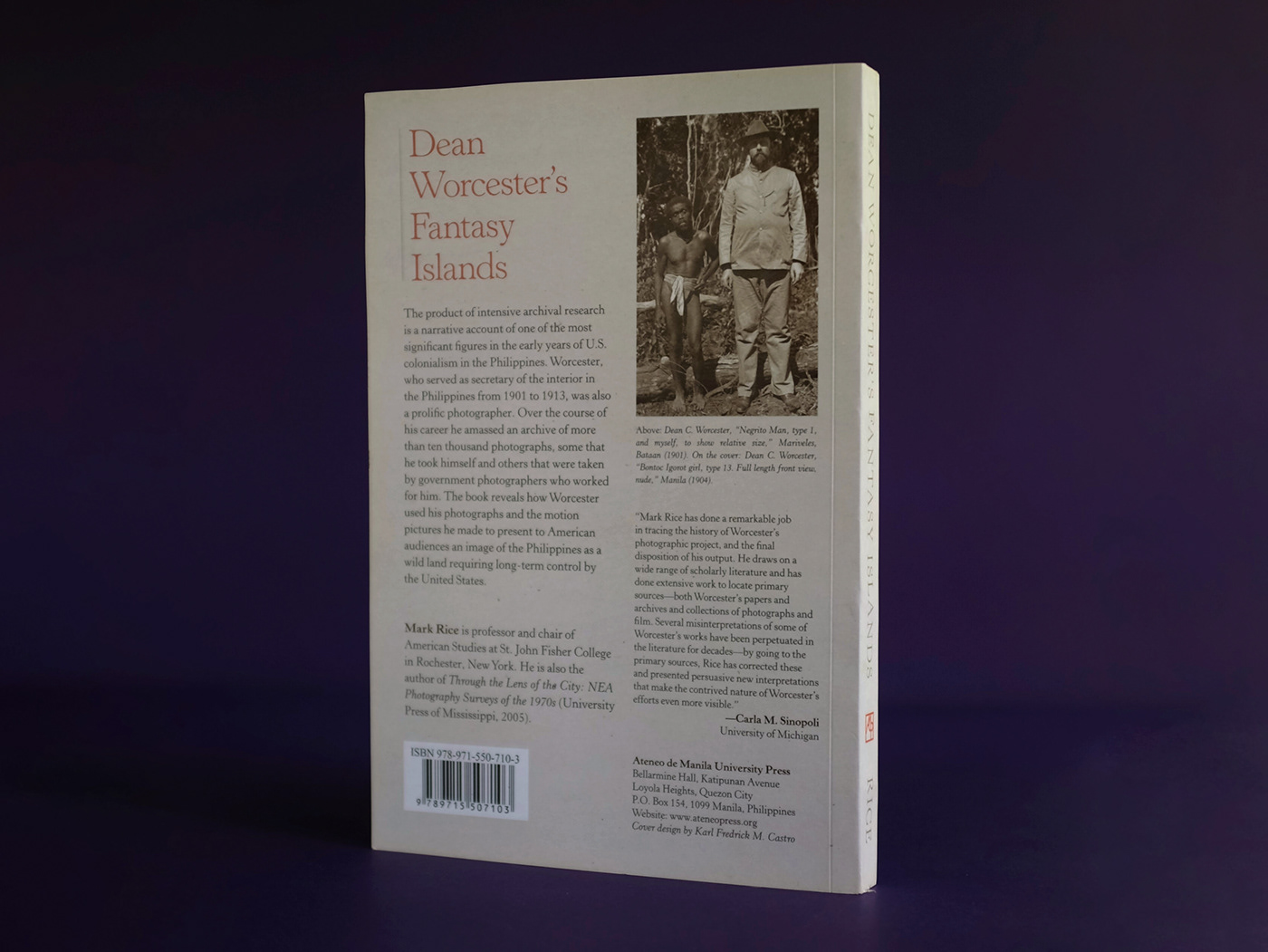
Dean Worcester's Fantasy Islands
A deeper look at colonial photography’s gaze
Dean Worcester's Fantasy Islands: Photography, Film, and the Colonial Philippines
Publisher: Ateneo de Manila University Press
Author: Mark Rice
Book dimensions: 6 × 9 in
Year: 2015
Winner, Best Book in Social Sciences, Gintong Aklat (Golden Book) Awards, 2016
Nominee, Best Book in History and Best Design, Philippine National Book Awards 2015
About the book
The strongest force keeping the Philippines under American control in the early 20th century may have come from a camera. From 1901 to 1913, Dean Worcester amassed thousands of photographs of “savage” Filipinos. These were subsequently circulated throughout the United States in various articles, books, and lectures. By imposing his own interpretations on his photographs, Worcester changed the way an entire Western nation viewed our people. —Publisher's description
Copublished with the University of Michigan Press.
“I believe in the teaching value of pictures.
Camera can be made to tell the truth.”
—Dean C. Worcester, 1913
Design notes: The politics of looking
The cover features a telling image: Worcester's 1904 photograph of an indigenous Bontoc Igorot girl, one in a series in preparation for the St Louis World’s Fair. The first two show her wearing a leaf skirt, while this one shows her nude, the leaf skirt at her feet. Worcester describes Bontoc Igorot women's everyday dress as just a “scanty” bark cloth skirt. Rice observes, however, that the girl in this photo has clear tan lines on her wrists and lower legs. Combined with her clenched expression and somewhat ashamed body language, Rice argues that the girl probably did not go around bare-breasted, or may never have worn a leaf-skirt like Worcester photographed her in.
One can be drawn to the innocuous qualities of the image: the girl's beauty, the way her posture recalls the grace of Botticelli's Venus, or the stark modernity of the pseudo-objective, timeless, “anthropological specimen” aesthetic of the plain white background. But we have to see this image as, primarily, a violent one.

“Educational Value of the Constabulary. 1. Bontoc Igorot on entering the service, 1901. 2. After a year’s service, 1902. 3. After two years’ service, 1903.” Illustration in Frederick Chamberlin, The Philippine Problem, 1898–1913.
The original University of Michigan Press edition had a different image on the cover, which highlights the manufactured quality of the images (and also a good contrast between native and Westerner, the literal shadow figure behind the whole production). But I selected the Bontoc Girl image because it is more subtle, therefore easier to miss, but nonetheless as potent—and it is important to highlight the gendered violence which is not as often discussed. The new cover design, I believe, would help ingrain that in our collective psyche, hopefully adding to the visual mnemonics we associate with Dean Worcester.

Left: “Negrito woman and Dean C. Worcester: Mariveles—1901.” Right: “Professor D Worcester in his laboratory: Philippine Islands.” University of Michigan Library Collection.
“In this fascinating and often chilling study, [Rice] pieces together the ways in which Worcester staged and manipulated photographs of what were called ‘non-Christian tribes’, rural ethnic minorities, to support the idea that the people of the Philippines overall were too diverse, too ‘uncivilized’ and ‘savage’, to rule themselves… Rice skilfully unravels the complex process through which ethnology, racism, politics, and photography intersected to create Worcester’s ‘fantasy islands’.”
—Eleanor M. Hight, History of Photography

The back cover features a photo of Worcester himself, who had a penchant of putting his six-foot-tall body side by side with natives, to illustrate the stark physical differences. Images like these helped cement racism against Filipinos and other non-Caucasian races, and boosted the American colonial project. I selected the two photos for the front and back covers to hint at Worcester’s various ways of subjugating, both in front of and behind the camera.
“In general, those photographs reinforce an image of the Philippines as inhabited primarily by non-Christian tribal minorities living a primitive existence. As recently as the 1970s, this image of the Philippines persisted in the supposed ‘discovery’ of the stone-age Tasaday people living on the Mindanao, a discovery later revealed to be a hoax.”
—Mark Rice, “Dean Worcester's Photographs and American Perceptions of the Philippines”
Related links
Buy from Ateneo Press
Read an article by Mark Rice
Read “Dean Worcester's Ethnographic Images of Filipinos, 1898-1912” by Christopher Capozzola






